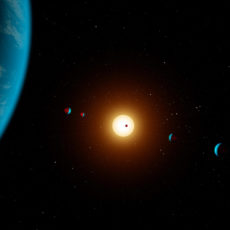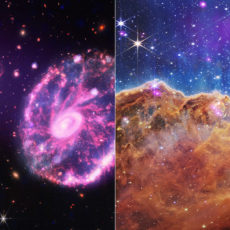
Galaxies collide in spectacular fashion, but a rare phenomenon dubbed a “cosmic joust” has astronomers talking. Observed in the AM 1054-325 system using the European Southern Observatory’s Very Large Telescope and ALMA, this event shows one galaxy piercing another, triggering a quasar that halts star formation.
Collisions between galaxies are slow, gravitational tangos spanning millions of years. In AM 1054-325, a smaller galaxy spears through the gas-rich disk of a larger one, sparking a quasar—a hyper-bright core fueled by a supermassive black hole. “This is the first time we’ve seen a galaxy actively ‘killing’ another by blasting away its star-forming fuel,” says Paulina Troncoso Iribarren, lead researcher at the Pontifical Catholic University of Chile. Unlike typical mergers, where galaxies blend messily, this is a precise strike, earning the “cosmic joust” label.
- NEXT GEN GAMING: Works with Nintendo Switch 2.
- READY FOR TOMORROW. Ready for future superspeed products with PCIe-NVMe interfaces and performs at UHS-I speeds when used with microS UHS-I and UHS-II...
- EXPONENTIALLY FASTER PERFORMANCE. Up to 4.4 times faster read speeds than our fastest microSD UHS-I cards[7] with up to 880MB/s[2] transfer speeds.

Why a joust? It’s like a medieval knight’s lance hitting a bullseye. The quasar unleashes jets—streams of particles and radiation moving near light speed—that slice through the target galaxy’s core. “The jet is so well-aligned that it pierces the heart of the companion galaxy, pushing gas out at incredible speeds,” explains Françoise Combes from the Paris Observatory. These jets act like a cosmic vacuum, sucking out gas needed for star formation. ALMA’s images reveal a gas trail, stretched like a comet’s tail, confirming the jet’s path.
As the smaller galaxy plunges through, it compresses gas, supercharging the quasar. The resulting jets don’t just disrupt—they evict the gas, starving the target galaxy of star-forming material. “We’re seeing the gas being swept away, leaving the galaxy starved,” says Mark Lacy from the National Radio Astronomy Observatory. This isn’t your average cosmic fender-bender; it’s a one-in-a-million event requiring perfect alignment. Most collisions mix gas and spark new stars, but this one shuts the process down.
The targeted galaxy could become a “red and dead” elliptical, barren of new stars. The quasar, meanwhile, might dim as it runs out of fuel. “This process shows how galaxies can regulate each other’s evolution in unexpected ways,” Combes notes. It’s a clue to why some galaxies stop forming stars sooner than expected, a long-standing puzzle. The Milky Way, for context, is nibbling on the Sagittarius dwarf galaxy, but nothing this dramatic has been spotted.
“It’s like catching a fleeting moment in the universe’s history,” Troncoso Iribarren says. The cosmic joust reveals a universe in constant flux, where galaxies don’t just drift—they duel, reshaping each other. “We’re witnessing a galactic duel that changes the course of both players,” Lacy adds. For anyone staring at the stars, this is a front-row seat to a cosmic showdown, proving the universe is anything but static.
[Source]










